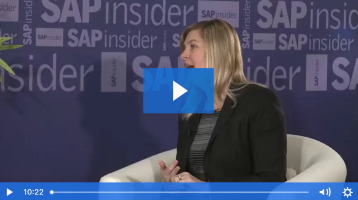4 Key Insights from SAP’s President of Customer Engagement & Experience About How Companies Can Thrive During Times of Disruption
By Brianna Shipley, Senior Editor, SAPinsider
One thing became clear after hearing the keynote, “Challenge or Opportunity: The Difference Between Surviving and Thriving During Times of Disruption,” delivered by SAP’s Thomas Bamberger, President of Customer Engagement & Experience, on the last day of SAPinsider’s Virtual Conference Experience: Companies that view times of disruption as an opportunity, rather than a challenge, will have a much better chance of success. Adopting a shift in mindset is often intangible, making this particular requirement difficult to measure and perhaps challenging to comprehend, but Bamberger provided guidance and insights to help the audience wrap their arms around the essential concept.
#1—Although the pandemic has played a significant role in widening the gap between companies coming out on the top versus the bottom, it is not the full story. Bamberger clarified that the trends we’re experiencing aren’t necessarily new, but rather “a great acceleration of trends that existed before the crisis,” such as online delivery, telemedicine, online classes, and remote work. “All trends were amplified by the crisis and we’re finding that customers that adapted quickly to changes in the industry are [fairing] best. [These companies] have changed their business models and are creating new and successful lines of business.” Bamberger named several examples of companies that have benefited from SAP technology to make these changes, including Vistaprint, Brakes Bros., and Parkland Health and Hospital System.
Explore related questions
#2—SAP customers continue to adopt SAP S/4HANA and the cloud at an increasing rate, however adoption is dependent on where each company is in its lifecycle. “Some [organizations] have decided to work on smaller projects rather than a migration but customers are making decisions based on business needs right now.” Bamberger cited some benefits of SAP S/4HANA that companies have experienced in their supply chains. These benefits were calculated pre-crisis and include 44% faster order lead times, 48% increase in procurement efficiency, and 85% acceleration time for MRP.
#3—Employees who have technology skills mixed with digital skills will undoubtedly have an advantage moving forward, but the necessity of these skills shouldn’t be confused with the equal demand for less tangible skillsets, such as how to maintain professional ties despite social distancing and learning advanced communication skills, including empathy. This latter skill is especially important for leaders, said Bamberger. Leaders should be equipping their employees to work remotely and empowering teams so they can more easily “adapt to changes in business models, focus on how the business has been impacted, and [understand] how they can help mitigate those situations.”
#4—The “wait and see mentality” will not work here. SAP customers should assume that we will be working this way for the foreseeable future, and plan accordingly, said Bamberger, which likely means a shift in priorities. Trends he is seeing as the path forward for companies that want to succeed: Migration to the cloud, shift to consumption-based pricing models, selling results and outcomes over features as well as industry-specific offerings, access to customer data to support the preference for remote services, extreme remote services and extreme automation.




